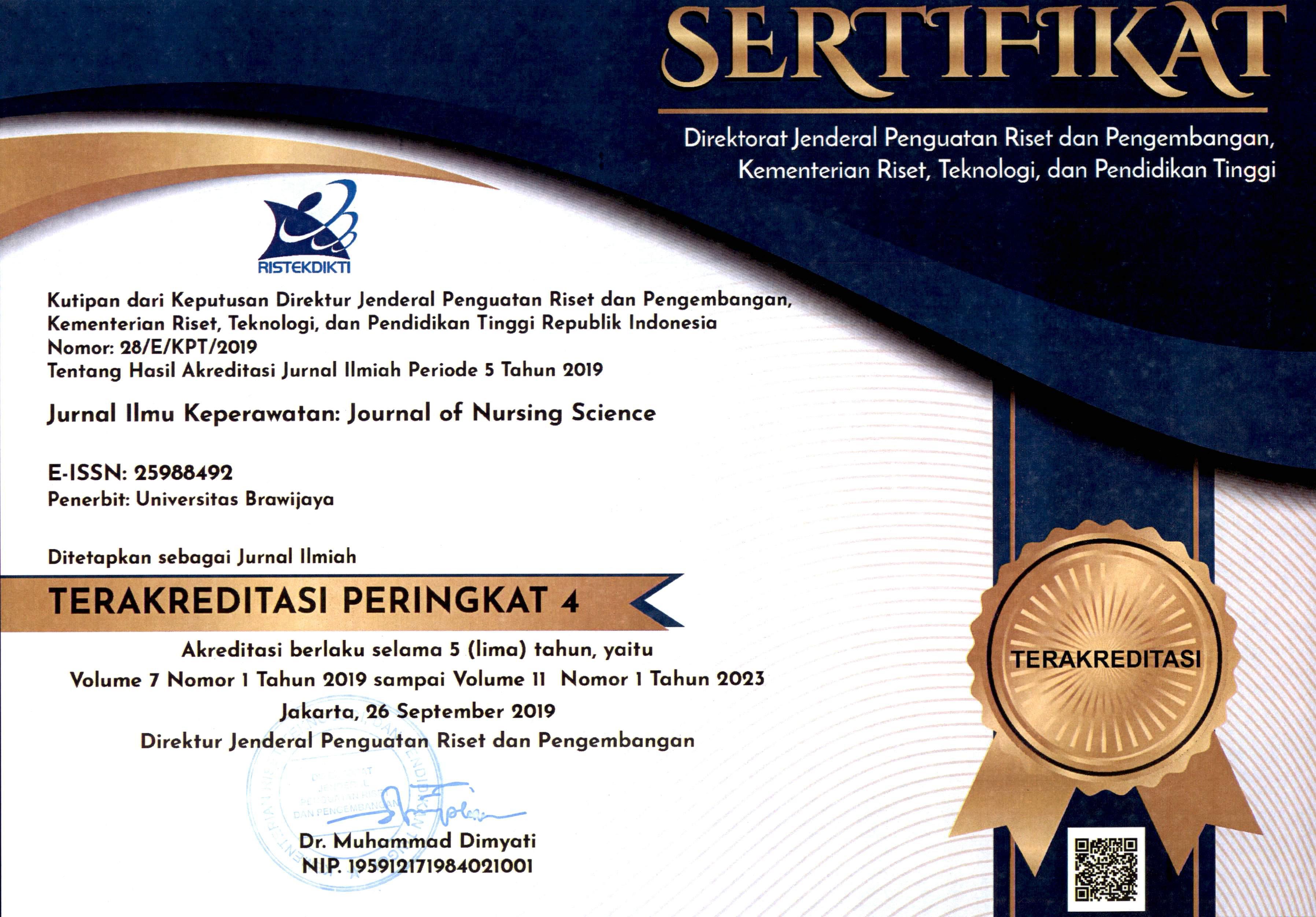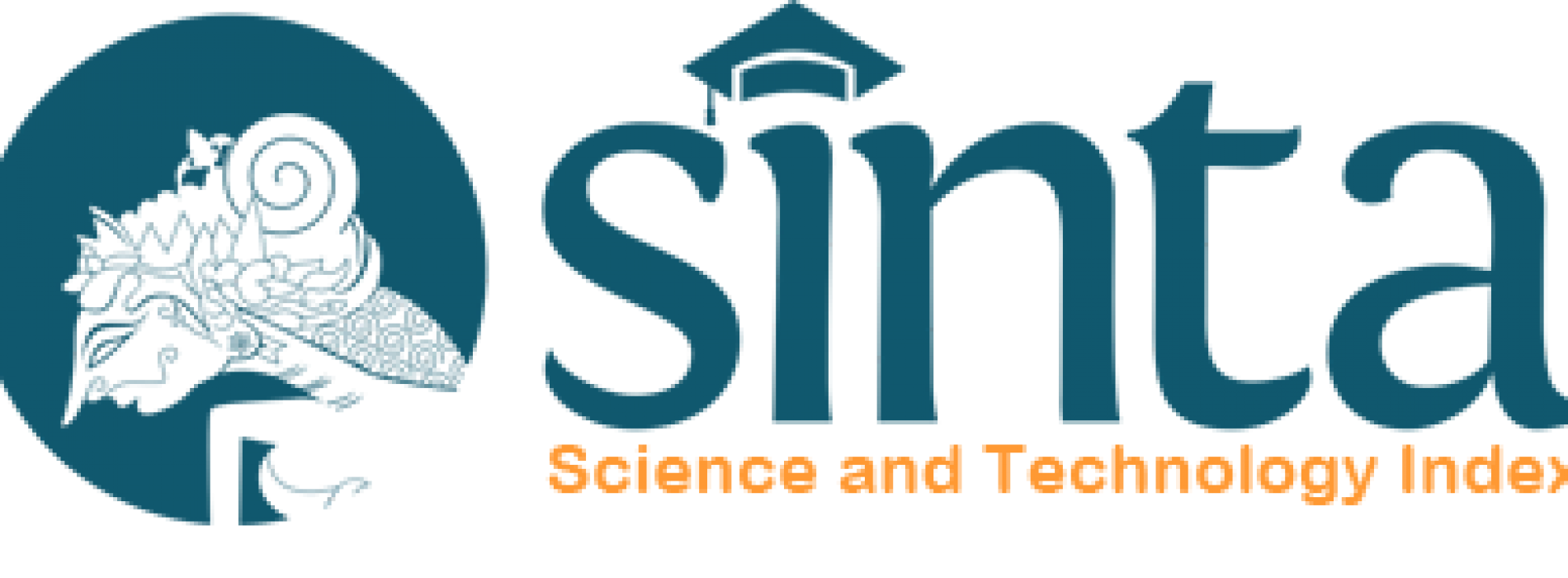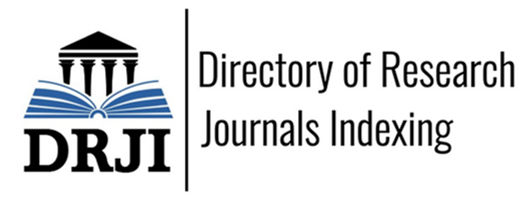COMPARISON OF NATIONAL EARLY WARNING SCORE (NEWS) AND REVISED TRAUMA SCORE (RTS) IN THE OUTCOME PREDICTION OF HEAD INJURY PATIENTS
DOI:
https://doi.org/10.21776/ub.jik.2019.007.02.4Keywords:
Head Injury, NEWS, Outcome, RTSAbstract
References
- Aprilia, H 2017, Gambaran status fisiologis pasien cedera kepala di IGD RSUD Ulin Banjarmasin tahun 2016. Dinamika Kesehatan, volume 8, nomor 1.
- Bouzat, P, Legrand, R, Gillois, P, Ageron, FX, Brun, J, Savary, D, et al. 2015, Prediction of intrahospital mortality after severe trauma: which prehospital score is the most accurate?, Injury.
- Campbell, J 2012, International trauma life support for emergency care provider 7th Edition, American College Emergency Physician, America, ISBN-13: 978013-215724-7.
- Celcilia, E 2015, Gambaran skor trauma pada pasien di UGD RSUD DR Soedarso Pontianak menggunakan Revised Trauma Score (RTS) periode tahun 2012, Program Studi Pendidikan Dokter Fakultas Kedokteran Universitas Tanjung Pura, Pontianak.
- Champion, HR, Sacco, WJ, Copes, WS, Gann, DS, Gennarelli, TA, Flanagan, ME 1989, A revision of the trauma score, J Trauma, vol. 29, pp. 623-9.
- Damanik, RP 2013, Karakteristik penderita cedera kepala akibat kecelakaan lalu lintas darat rawat inap di RSUD Dr. H. Kumpulan Pane Tebing Tinggi tahun 2010-2011, Gizi Kesehatan Reproduksi dan Epidemiologi, volume 2, nomor 4.
- Eaton, J, Hanif, AB, Grudziak, J, Charles, A 2017, Epidemiology, management, and functional outcomes of traumatic brain injury in sub- Saharan Africa, World Neurosurgery, doi: 10.1016/j.wneu.2017.09.084.158
- Hidayat, AA 2008, Metode penelitian keperawatan dan teknik analisis data, Salemba Medika, Jakarta.
- Ikatan Ahli Bedah Indonesia Komisi Trauma IKABI 2008, Advanced trauma life support for doctors, America College of Surgeon Committee on Trauma
- Japardi, I 2004, Cedera kepala: memahami aspek-aspek penting dalam pengelolaan penderita cedera kepala, PT Bhuana Ilmu Populer, Jakarta.
- Jeong, JH, Yong, JP, Dong, HK, Tae, YK, Chang, WK, Soo, HL, et al. 2017, The New Trauma Score (NTS): a modification of the revised trauma score for better trauma mortality prediction, BMC Surgery, vol. 17, no. 77.
- Jones, M 2012, NEWSDIG: the national early warning score development and implementation group, Clinical Medicine, vol. 12, no. 6, pp. 501-503.
- Kim, YJ 2012, Injury severity scoring systems: a review of application to practice, British Association of Critical Care Nurses, vol.17, no. 3.
- Laytin, AD, et al. 2017, Comparing traditional and novel Injury scoring systems in a US level I trauma center: an opportunity for improved injury surveillance in low and middle income countries, Journal of Surgical Research, volume 215, pp.60-66.
- National Institute for Health and Care Excellence 2014, Head injury: assessment and early management, United Kingdom,
- Nurfaise 2012, Hubungan derajat cedera kepala dan gambaran CT Scan pada penderita cedera kepala di RSU DR. Seodarso periode Mei-Juli 2012, Program Studi Pendidikan Dokter Fakultas Kedokteran Universitas Tanjungpura, Pontianak.
- Nursalam 2015, Metodologi penelitian ilmu keperawatan: pendekatan praktis edisi 4, Salemba Medika, Jakarta.
- Putra, DSE, Muhammad, RI, Djanggan, S, & Mukhamad, F 2016, Nilai skor Glassgow Coma Scale, Age,Systolic Blood Pressure (GAP SCORE) dan saturasi oksigen sebagai prediktor mortalitas pasien cidera kepala di Rumah Sakit Saiful Anwar Malang, Jurnal Hesti Wira Sakti, volume 4, no. 2, pp. 13-28.
- RSUD Ulin Banjarmasin Provinsi Kalimantan Selatan 2017, diakses 22 Januari 2017, pukul 08.10 WITA, <http://rsulin.kalselprov.go.id/>.
- Rahmawati, I 2013, Analisis faktor-faktor yang berhubungan dengan nilai Revised Trauma Score dalam memprediksi mortality pasien cedera kepala berat di RSD. Mardi Waluyo Blitar, Universitas Brawijaya.
- Ranti, JSR, Heber, BS, Laurens, TB, Kalesaran 2016, Aplikasi revised trauma score, injury severity score, dan trauma and injury severity core dalam memprediksi mortalitas pada pasien multitrauma di IRDB BLU RSUP Prof. Dr. R. D. Kandou Manado, Jurnal Biomedik (JBM), volume 8, nomor 2.
- Riset Kesehatan Dasar (RISKESDAS) 2013, Badan Penelitian dan Pengembangan Kesehatan Kementrian Kesehatan Republik Indonesia, diakses 10 Oktober
- , pukul 21.30 WITA, .
- Ristanto, R 2016, Akurasi revised trauma score sebagai prediktor mortality pasien cedera kepala, Jurnal Kesehatan Hesti Wira Sakti, volume 4, nomor 2, pp. 79–90.
- Ristanto, R 2017, Deskripsi klien cedera kepala yang mengalami trauma mayor, Jurnal Kesehatan Hesti Wira Sakti, volume 5, nomor 1, pp. 48–55.
- Royal College of Physicians 2012, National Early Warning Score (NEWS): standardizing the assessment of acute-illness severity in the NHS report of a working party, RCP,
- London.
- Salehi, O, et al. 2016, A new injury severity score for predicting the length of hospital stay in multiple trauma patients, Trauma Mon, vol. 21, no. 1.
- Salim, C 2015, Sistem Penilaian trauma, CDK- 232, vol. 42, no. 9.
- Sastroasmoro, S 2014, Dasar-dasar metodologi penelitian klinis edisi ke-5, Sagung Seto, Jakarta.
- Sastrodoningrat, AG 2006, Pemahaman indikator-indikator dini dalam menentukanprognosa cedera kepala berat, Suplemen Majalah Kedokteran Nusantara, vol. 39,
- no. 3.
- Saudin, D, & Mukamad, R 2017, Penerapan sistem penilaian trauma Revised Trauma Score (RTS) untuk menentukan mortalitas pasien trauma di triage instalasi gawat darurat, Jurnal Kesehtan Hesti Wira Sakti, vol. 5, no. 1, pp. 12–15.
- Simanjuntak, F, Danny, JN, Corry, NM 2015, Gambaran pasien cedera kepala di RSUP Prof. DR. R.D. Kandou Manado periode Januari 2013-Desember 2013, Jurnal e-Clinic (eCl), vol. 3, no. 1.
- Spangfors, M, Lisa, A, Victoria, K, & Karin, S 2016, The national early warning score: translation, testing, and prediction in a Swedish setting, Intensive and Critical Care Nursing.
- Sugiyono 2009, Metode penelitian kuantitatif kualitatif dan R&D, Alfabeta, Bandung.
Downloads
Published
How to Cite
License
Authors published in this journal agree to the following terms:
1. The copyright of the received article shall be assigned to the journal as the publisher of the journal. The intended copyright includes the right to publish the article in various forms (including reprints). The journal maintains the publishing rights to the published articles.
2. Authors may enter into separate additional contractual agreements for the non-exclusive distribution of the published journal version of the work (for example, posting it to an institutional repository or publishing it in a book), with acknowledgment of their initial publication in this journal.
3. Authors are permitted and encouraged to post their work online (e.g. in an Institutional Repository or on their website) before and during the submission process, as this can result in a productive exchange, as well as earlier and larger citations of the published work.
4. Articles and all related material published are distributed under Creative Commons Attribution-NonCommercial 4.0 International License or CC BY-NC 4.0 license.
JNSU is licensed under a Creative Commons Attribution-NonCommercial 4.0 International License or CC BY-NC 4.0 license.
Most read articles by the same author(s)
- Laila Agustina, Abdurahman Wahid, Ifa Hafifah, ANALYSIS OF THE EFFECTIVENESS OF NATIONAL EARLY WARNING SCORE (NEWS) USAGE ON THE OUTCOMES OF HEAD INJURY , Journal of Nursing Science Update (JNSU): Vol. 6 No. 2 (2018)
- Ahmad Lathif, Abdurahman Wahid, Ifa Hafifah, THE INFLUENCE OF CPR MEASURES TRAINING TOWARD KNOWLEDGE AND MOTIVATION TO HELP THE VICTIM OF CARDIAC ARREST IN HIGH SCHOOL STUDENT OF DARUL HIJRAH PUTERA ISLAMIC BOARDING SCHOOL , Journal of Nursing Science Update (JNSU): Vol. 6 No. 2 (2018)
- Musyarrofah Musyarrofah, Abdurahman Wahid, Rismia Agustina, THE DEAD OF MILD AND MODERATE HEAD INJURY , Journal of Nursing Science Update (JNSU): Vol. 6 No. 2 (2018)
- Rifda Nur Achriyana Arif, Abdurrahman Wahid, Ifa Hafifah, Gia Eka Negara, Effectiveness of Thermos to Maintain the Temperature of Ringer Lactate and Normal Saline 0.9% at AC Temperature 18ËšC , Journal of Nursing Science Update (JNSU): Vol. 9 No. 2 (2021)





























